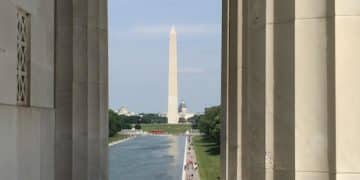Federal Reserve Rate Cuts in Late 2025: What’s the Outlook?

The Federal Reserve is signaling potential interest rate cuts in late 2025 in response to cooling inflation and moderate economic growth, reflecting a shift toward easing monetary policy to balance economic stability and manage inflation expectations.
Are you wondering when the Federal Reserve might lower interest rates? Recent signals suggest potential rate cuts are on the horizon in late 2025. Keep reading to understand what factors are influencing these potential changes and what they could mean for you.
Federal Reserve Signals Potential Rate Cuts in Late 2025: What to Expect
The Federal Reserve’s signals of potential rate cuts in late 2025 have captured the attention of investors, economists, and the general public alike. After a period of aggressive rate hikes aimed at curbing inflation, these signals suggest a possible turning point in monetary policy. Understanding the factors driving this shift and the potential implications is crucial for making informed financial decisions.
This article delves into the reasons behind the Federal Reserve’s potential move, the economic context surrounding the decision, and what individuals and businesses can expect in the coming months. By examining recent economic data, Fed pronouncements, and expert analysis, we aim to provide a comprehensive overview of the situation.
Understanding the Fed’s Current Stance
To grasp the significance of potential rate cuts, it’s essential to understand the Federal Reserve’s current position. Over the past few years, the Fed has been focused on combating inflation through a series of interest rate increases. These hikes have had a ripple effect throughout the economy, impacting everything from mortgage rates to business investments.
The Federal Reserve’s dual mandate is to maintain price stability and maximize employment. Balancing these two goals often requires navigating complex economic conditions. Recently, the Fed has been closely monitoring inflation data and economic growth indicators to determine the appropriate course of action.
Key Economic Indicators
Several economic indicators play a crucial role in the Federal Reserve’s decision-making process. These include:
- Inflation Rate: The rate at which the general level of prices for goods and services is rising, and subsequently, purchasing power is falling.
- Unemployment Rate: The percentage of the labor force that is unemployed but actively seeking employment.
- GDP Growth: The rate at which a country’s economy is growing or shrinking.
- Consumer Spending: Household spending on goods and services.
These indicators provide insights into the overall health of the economy and help the Fed gauge whether its current policies are achieving the desired outcomes.
Recent Fed Actions
In recent months, the Federal Reserve has held interest rates steady, signaling a potential shift in strategy. This pause allows the Fed to assess the impact of previous rate hikes and evaluate the evolving economic landscape.
Recent meetings of the Federal Open Market Committee (FOMC) have revealed a growing consensus among members that inflation is gradually moving towards the Fed’s 2% target. This progress has paved the way for discussions about potential rate cuts in the future.
In conclusion, the Federal Reserve’s current stance is one of cautious optimism. While inflation remains a concern, there are signs that the economy is responding to the Fed’s policies, potentially setting the stage for rate cuts in late 2025.

Factors Influencing Potential Rate Cuts
Several factors are influencing the Federal Reserve’s consideration of interest rate cuts in late 2025. These range from moderating inflation to concerns about economic growth and global economic conditions. Understanding these factors is essential for anticipating future policy decisions.
The interaction of these factors creates a complex situation for the Federal Reserve. Balancing the need to keep inflation in check with the desire to support economic growth requires careful consideration and a data-driven approach.
Moderating Inflation
One of the primary reasons for considering rate cuts is the gradual moderation of inflation. After peaking in 2022, inflation has been steadily declining, thanks in part to the Fed’s aggressive rate hikes. While inflation remains above the Fed’s 2% target, the downward trend is encouraging.
The consumer price index (CPI) and the personal consumption expenditures (PCE) price index are two key measures of inflation that the Fed monitors closely. Recent data show that both CPI and PCE are moving in the right direction, albeit at a slower pace than initially hoped.
Economic Growth Concerns
While moderating inflation is a positive sign, there are also concerns about the potential impact of high interest rates on economic growth. Elevated borrowing costs can dampen business investment and consumer spending, leading to slower economic expansion.
Some economists worry that keeping interest rates too high for too long could trigger a recession. To avoid this outcome, the Federal Reserve must carefully calibrate its monetary policy to balance inflation control with economic growth support.
Global Economic Conditions
Global economic conditions also play a role in the Federal Reserve’s decision-making process. A slowdown in global growth or increased geopolitical risks could prompt the Fed to adopt a more dovish stance.
- Geopolitical Risks: Events such as trade wars, political instability, and international conflicts can disrupt global supply chains and impact economic activity.
- Global Growth: Slower growth in major economies like China and Europe can have a ripple effect on the U.S. economy.
- Exchange Rates: Fluctuations in exchange rates can impact the competitiveness of U.S. exports and imports.
In summary, the Federal Reserve’s decision to consider rate cuts is driven by a combination of moderating inflation, concerns about economic growth, and global economic uncertainties. These factors create a complex and dynamic environment that requires careful monitoring and analysis.
Potential Impacts of Rate Cuts
If the Federal Reserve does decide to cut interest rates in late 2025, the move could have significant impacts on various sectors of the economy. Lower rates can stimulate borrowing and spending, potentially boosting economic growth.
However, the effects of rate cuts are not always straightforward. It’s important to consider the potential risks and unintended consequences of such a policy shift.
Impact on Consumers
For consumers, lower interest rates can translate into lower borrowing costs for mortgages, auto loans, and credit cards. This can free up more disposable income and encourage spending.
Lower mortgage rates can also make homeownership more affordable, potentially boosting the housing market. Additionally, lower rates can reduce the cost of student loans and other forms of consumer debt.
Impact on Businesses
Businesses can also benefit from lower interest rates. Reduced borrowing costs can incentivize companies to invest in new projects, expand their operations, and hire more workers. This can lead to increased economic activity and job creation.
Lower rates can also make it easier for businesses to refinance existing debt, freeing up capital for other purposes. However, it’s important to note that the impact of rate cuts on businesses can vary depending on the industry and the overall economic climate.
Impact on Investors
Investors may also see changes in their portfolios as a result of rate cuts. Lower interest rates can make bonds less attractive, as their yields decline. This can lead investors to seek higher-yielding assets, such as stocks and real estate.
- Stock Market: Rate cuts can often lead to a rally in the stock market, as investors anticipate increased economic growth and corporate profits.
- Bond Market: Bond prices typically rise when interest rates fall, as existing bonds become more valuable.
- Real Estate: Lower mortgage rates can boost demand for real estate, leading to higher property values.
In conclusion, rate cuts can have a wide-ranging impact on consumers, businesses, and investors. However, the effects are not always predictable, and it’s important to consider the potential risks and benefits of such a policy shift.

Expert Opinions and Forecasts
Economists and market analysts have offered a range of opinions and forecasts regarding the Federal Reserve’s potential rate cuts in late 2025. These experts closely monitor economic data, Fed pronouncements, and global events to provide insights into the likely course of monetary policy.
While there is some consensus among experts, there are also varying perspectives on the timing, magnitude, and impact of potential rate cuts.
Bullish Perspectives
Some economists hold a bullish view, arguing that the Federal Reserve will likely begin cutting interest rates in late 2025 due to moderating inflation and the risk of an economic slowdown. They believe that lower rates will stimulate economic growth and boost corporate profits.
These experts point to the fact that inflation has been steadily declining and that the labor market is showing signs of cooling. They argue that the Fed needs to act proactively to prevent a recession.
Bearish Perspectives
Other analysts are more cautious, suggesting that the Federal Reserve may delay rate cuts until there is more evidence that inflation is under control. They worry that cutting rates too soon could reignite inflationary pressures.
These experts emphasize that inflation remains above the Fed’s 2% target and that there is still a risk of further price increases. They argue that the Fed should remain patient and wait for more data before easing monetary policy.
Consensus Forecasts
The consensus among economists is that the Federal Reserve will likely begin cutting interest rates in late 2025, but the timing and magnitude of these cuts are uncertain. Most experts expect the Fed to proceed cautiously, with gradual rate reductions over time.
- Timing: The majority of economists expect the first rate cut to occur in the fourth quarter of 2025.
- Magnitude: Most forecasts call for a total of 0.5 to 1.0 percentage points in rate cuts over the course of 2025.
- Impact: The consensus view is that rate cuts will provide a moderate boost to economic growth and corporate profits.
In summary, expert opinions and forecasts regarding potential rate cuts vary, but the consensus is that the Federal Reserve will likely begin easing monetary policy in late 2025. However, the timing and magnitude of these cuts remain uncertain.
Strategies for Navigating Potential Rate Cuts
As the Federal Reserve signals potential rate cuts in late 2025, individuals and businesses should consider strategies for navigating this evolving economic landscape. Preparing for potential rate cuts can help you make informed financial decisions and capitalize on emerging opportunities.
These strategies involve careful planning, risk management, and a proactive approach to financial management.
For Individuals
Individuals can take several steps to prepare for potential rate cuts. These include:
- Refinancing Debt: If you have outstanding debt, such as a mortgage or student loan, consider refinancing to take advantage of lower interest rates.
- Adjusting Investments: Rebalance your investment portfolio to align with your risk tolerance and investment goals. Consider increasing your exposure to stocks and real estate, which may benefit from lower rates.
- Saving and Budgeting: Continue to save and budget responsibly, even as borrowing costs decline. This will help you maintain financial stability and prepare for future opportunities.
For Businesses
Businesses can also take steps to prepare for potential rate cuts. These include:
Evaluate your debt structure and consider refinancing existing loans to reduce borrowing costs.
Assess your capital investment plans and consider launching new projects that may be more affordable with lower rates.
Review your pricing strategy and consider adjusting prices to reflect lower borrowing costs.
General Financial Planning
Regardless of whether you are an individual or a business, it’s important to review your overall financial plan and make adjustments as needed. This includes:
- Risk Management: Assess your risk tolerance and ensure that your financial plan is aligned with your comfort level.
- Diversification: Diversify your investments to reduce risk and maximize potential returns.
- Professional Advice: Consult with a financial advisor to get personalized guidance and develop a comprehensive financial plan.
In conclusion, navigating potential rate cuts requires careful planning, risk management, and a proactive approach to financial management. By taking these steps, individuals and businesses can position themselves to capitalize on emerging opportunities and achieve their financial goals.
Conclusion
The Federal Reserve’s signals of potential rate cuts in late 2025 represent a significant shift in monetary policy. These signals are driven by a combination of moderating inflation, concerns about economic growth, and global economic uncertainties. While the exact timing and magnitude of these cuts remain uncertain, it’s clear that the Fed is preparing to ease monetary policy in the coming months. By understanding the factors driving this shift and the potential implications, individuals and businesses can make informed financial decisions and navigate the evolving economic landscape effectively.
| Key Point | Brief Description |
|---|---|
| 📉 Inflation Moderation | Inflation is declining, prompting consideration of rate cuts. |
| ⚠️ Economic Growth | Concerns about slowing growth may lead to rate cuts. |
| 💼 Business Impact | Rate cuts can lower borrowing costs for businesses. |
| 💰 Consumer Benefits | Consumers may see lower rates on mortgages and loans. |
FAQ Section
▼
The Federal Reserve is signaling potential rate cuts in late 2025, influenced by moderating inflation and concerns about economic growth. These cuts could begin as early as the fourth quarter, but the exact timing remains uncertain.
▼
Several factors could delay rate cuts, including persistent inflation above the Fed’s 2% target, stronger-than-expected economic growth, or unforeseen global economic shocks that create uncertainty and instability.
▼
Consumers can prepare by considering refinancing debt to lock in lower rates on their mortgages and loans. It is also wise to adjust investments to align with your risk tolerance and financial planning objectives.
▼
Rate cuts may lower borrowing costs for firms, encouraging them to invest in new projects and expand operations. Decreased costs can then translate to revenue and industry growth, resulting in higher profits.
▼
Investment strategies should include diversifying portfolios to maximize returns, and considering stocks and real estate, which tend to increase during rate cut periods. Consulting a financial advisor is also a great option.
Conclusion
In conclusion, the potential for Federal Reserve rate cuts in late 2025 is shaped by a complex interplay of economic factors. Monitoring these developments and adjusting financial strategies accordingly will be crucial for navigating the evolving economic landscape and achieving long-term stability and growth.





